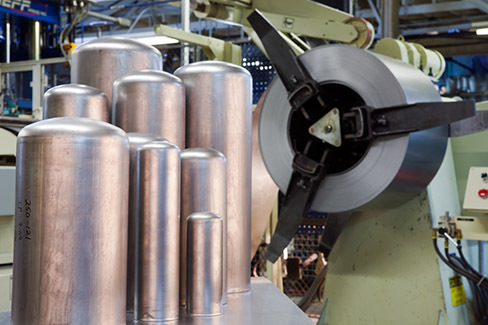The Deep Draw Distinction in Metal Stamping: Cutting Weight = Cutting Costs
Who doesn’t want to save money and improve efficiency with their production costs? No product designer, manager, engineer, or C-Suite exec we’ve ever met. How about you? And when you source a metal forming job that requires deep draw expertise, every vendor is going to tell you they can do it cost effectively. But can they prove it? We actually can – in cold hard steel cost savings – with data to back it up. Check out one case study here.
Let’s start from the beginning. You bring your project to us, and we discuss its  parameters: metal forming technique, material requirements, volume, frequency, tooling needs, etc. We explore your design for manufacturability, if needed; we ensure the engineering and performance specs are aligned; we design and build your tool; we manufacture your part or component.
parameters: metal forming technique, material requirements, volume, frequency, tooling needs, etc. We explore your design for manufacturability, if needed; we ensure the engineering and performance specs are aligned; we design and build your tool; we manufacture your part or component.
But : there is so much more that goes into an effective partnership with your metal stamper or deep draw expert.
Tangible Benefits
We are a vertically integrated production facility. We do everything in-house, which means we:
- Perform initial design for manufacturability (DFM) reviews with you to ensure you get the best performance and value from your part.
- Engineer the optimal manufacturing process, and follow it through using our advanced quality planning (AQP) tools.
- Design and build all tooling, fixtures and process automation—and do all subsequent maintenance in-house.
- Specify and order the raw materials; we work closely with the mills, even custom ordering the chemical and physical characteristics of materials as required to get the exact draw and forming results you require.
- Measure and validate the process using statistical controls, monitor for continual improvements, and provide vital feedback and cost-savings suggestions.
- Perform any value-added work to make your product as cost-effective a solution for you as possible.
Why this matters: because from beginning to end, we are accountable for everything regarding your component or part. We take this responsibility very seriously and stake our well-respected reputation on producing the highest quality products.
There are many elements that comprise a successful production process. The one we want to discuss in more detail here involves Larson’s proprietary process with deep draw metal forming. Coming up on our 100-year anniversary, it’s not an understatement to say that we, well, draw from extensive experience. During our long history in metal forming, we have developed processes that offer customers unique cost saving advantages as well as improve the quality and performance of their parts.
More Aggressive Deep Draw Methods Yield Optimal Wall Thickness While  Retaining Strength
Retaining Strength
Conventional wisdom and standard practice in the deep draw industry call for several operations to achieve a deep drawn shell. High-strength steels require even more draws with expensive annealing operations to relieve the resultant work hardening.
Larson Tool & Stamping is known in the industry for our deep draw process and sidewall expertise. We have developed proprietary deep draw processes that achieve the end product, in many cases, without annealing. This results in a less expensive process while retaining the benefits of work-hardening the sidewall. We see gains of as much as 45 to 50% more strength over the base material.
Part of our proprietary developments include custom chemical and physical characteristics of materials that work alongside our processes to save time and still get the desired specifications.
This is important, especially for canisters used in pressure vessel applications. We have the ability to work-harden the sidewall to withstand the pressure you need, but with a thinner material. Larson can apply this process to produce a wide range of deep drawn canisters with a wide range of performance characteristics.
Material Matters
While we do work with special materials, the most commonly used materials are 300 series, 400 series stainless steels, and 1008-1010 cold-rolled steel. Once we know what the performance, design, and production requirements are for a part or component, we can reverse engineer to determine the optimal wall thickness—aiming for the thinnest threshold while maintaining strength. Then we work with our steel mill vendors to fine-tune the alloying elements of the steel to get the best outcome for wall thickness and strength. On average, we have been able to achieve wall thickness reductions of up to 12% for our customers.
Cost Savings on Thinner-Wall Canisters
As mentioned above, there are tangible, proven benefits of producing thinner-walled canisters. Here’s a breakdown of all the benefits of Larson’s proprietary deep draw process:
- Reduced product cost: we use less material overall, and can save customers money on materials
- Helps reduce manufacturing cost and production time: every draw adds to production costs, as it does to processing time; both are reduced with our process
- Helps optimize transportation costs: overall weight is reduced, allowing for more efficient transportation logistics and costs
- Increased quality: the strength integrity of the wall remains intact—sometimes is stronger with customized metallurgy—making the product more resistant to scratches, dings, and dents
- Increased canister volume for end-use product: thinner walls create more internal volume for the same outside diameter, allowing for more product to fill internally or pressure accumulation
- Tooling and tool maintenance savings: less operations to produce a drawn shell means reduced tooling cost, as well as less tooling to maintain, and less downtime
- Improved ergonomics: thinner wall canisters are lighter weight and easier to handle, allowing for speed of movement and providing more favorable ergonomics when working with the end-use application of the product
Deep Draw Experts
As industry experts in deep draw, we have a massive capacity to produce deep drawn shells in progressive, as well as automated transfer, equipment. You can view specifications of the deep draw presses and progressive die presses on our Facility page. If you are curious about how to assess details, such as material selection, tolerances, chemistry and other factors when designing parts for metal stamping, you can find out more by downloading our Metal Stamping Design Guide.
Larson Tool works with our customers from the earliest stages of design to optimize your part design for the metal stamping process and determine the best materials, tooling, and process solutions for your product. We’ll leverage our years of experience in the industry to help you with all your metal stamping needs. Contact us today for help regarding your deep draw stamping initiatives!

